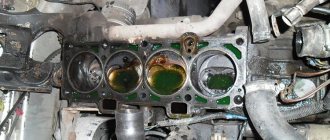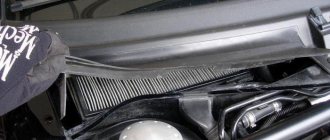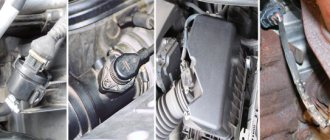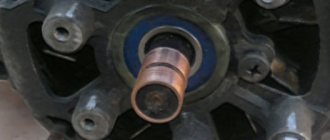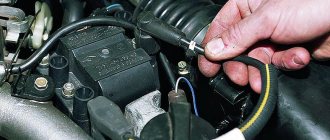Usually in the fall or winter, car owners find that the engine in the car does not warm up to 90 ° C, that is, operating temperature. Why does the VAZ 2114 engine not heat up, what are the causes of the problems and what are the methods for eliminating them?
The engine does not heat up
There are several possible reasons for poor engine warm-up:
- faulty thermostat;
- ruptures and cracks in pipes;
- faulty sensors;
- air in the system;
- low quality fuel.
How does the engine warm up?
Each serviceable unit has a different warm-up time. It is influenced by:
- degree of forcing;
- engine type: diesel or gasoline;
- cooling system condition;
- stove operation;
- quality of antifreeze or antifreeze;
- work load;
- outside air temperature;
- type and viscosity of engine oil.
The characteristics of the oil are rarely taken into account, but experts believe that this is necessary. Various friction reducing additives and the base stock, synthetic or semi-synthetic, affect the performance in the range of 5–7 degrees. Thus, the engine will heat up faster with thinner synthetic oil.
The engine temperature gauge does not rise often due to a malfunction of the thermostat. It is with this unit that the system check always begins if the engine takes a long time to warm up to operating temperature.
What can be dangerous about a cold engine?
If you notice that the engine has not warmed up to operating temperature and it cannot rise, then you should start immediately troubleshooting, as the consequences can lead to serious expenses for repairs.
The electronic control unit installed on modern cars recognizes an unheated engine as a cold one. If it cannot warm up and the engine temperature does not rise, then an over-enriched mixture is supplied.
When the system has to operate in this mode, the spark plugs fail due to the appearance of carbon deposits on them and on the internal elements. Thus, you can significantly reduce the service life and face major repairs, which cost a lot of money.
If the engine does not warm up to operating temperature, you should immediately contact a car service to diagnose the problem so that similar malfunctions do not occur in the future.
Principle of operation
Coolant enters the radiator through the thermostat. This is a large circle of fluid circulation. The thermostat usually opens at a temperature of 100 degrees Celsius. If the temperature has not reached this limit, then the liquid moves in a small circle. A thermostat malfunction is manifested by improper opening of the valves.
When the thermostat is closed, the engine overheats, and a constantly open one leads to low temperatures, since the liquid will only flow in a large circle.
Due to irregular changes of antifreeze or antifreeze, use of running water or mixing of coolants, various deposits in the form of scale may accumulate in the system. In this case, the thermostat will inevitably jam in one of its positions.
Using water as a cooling medium
The use of water to cool the power plant in winter is not recommended, but is allowed. The system must be filled with already heated water to avoid difficult starting of the engine with increased wear of parts. The radiator and motor must be insulated. Heated water must be poured with the drain valves open several times. Then close the taps, fill the system and start starting.
After the end of the trip, the liquid must be drained when it cools down to 45-50 degrees. If you empty the system immediately upon arrival, cracks and other defects may appear. Leaving the water system in frosty conditions is unacceptable. When freezing, the liquid will expand and render the engine, radiator and other components unusable.
Checking the Thermostat
To diagnose the malfunction, you should contact a service specialist. However, you can check the thermostat yourself. The cold engine is allowed to idle for approximately 10 minutes. After this, you need to check the radiator pipes. If the thermostat is functioning properly, the hoses will not become hot. The temperature rises only at the moment when the coolant begins to circulate in a large circle.
The coolant enters the large circle only after reaching operating temperature. If the pipes begin to heat up before the specified point, you should immediately contact a technician for further diagnosis and troubleshooting. There are also more professional diagnostic methods using special sensors. Such a check can be carried out at a service station.
If the device does not open and close completely, partial overheating may occur or the temperature will rise, but very slowly. Also, the wedge can be observed only periodically.
Any specified defect requires careful examination and repair. If you do not have the necessary skills and minimal knowledge about the internal structure of a car, you should contact qualified car service specialists.
To remove the thermostat, you must first get rid of the liquid in the system. It is important to wait until the entire system has cooled down before replacing the part. Removing the thermostat is quite simple; to do this, just unscrew the three bolts located on the cover and remove it together with the thermostat.
Taking into account all the design features of this model, it can be replaced with an identical or suitable analogue. Well-known brands produce units that can be interchanged, so there are no difficulties with selection. In any case, all manipulations must be carried out by a person who knows exactly what needs to be done, takes into account the make, year of manufacture, and mileage of the car.
It is very important to consider that the cost of this part is quite low, so it would be more appropriate to replace it than to repair it. Thus, you can get rid of problems with low engine temperature for the entire winter season.
Since when replacing the thermostat you will have to drain the fluid, it is worth checking the engine for performance before the start of the winter season. Many car owners pour antifreeze into the system and then face the need to replace the unit, therefore paying twice for the coolant.
The engine temperature arrow does not rise, the engine temperature fluctuates, the engine cools down while driving
The time it takes for the engine to warm up to operating temperature may vary for each serviceable unit. This happens because the heating and its intensity depend on a number of conditions. The warm-up speed can be affected by the power of the engine, its type (gasoline/diesel), the general condition of the cooling system, the quality of the fill, the outside temperature, the degree of load when driving, the intensity of the heater in the cabin, and so on.
Let us add that many experts agree that different types of motor oils and their viscosity can also affect the overall heating of the engine, although only slightly. The operating temperature of the oil in a conventional engine is around 100-150 degrees, not exceeding the maximum threshold of about 200 degrees (all indicators are averaged). In parallel with this, the maximum oil temperature in the engine is determined by the flash point of the oil, its coking, etc.
It may seem that the temperature range will be the same for different oils, but this is not the case. Special additive packages that reduce friction losses and the base itself () affect the degree of oil heating. In other words, low-viscosity oils cool rubbing couples better, but the lubricant itself heats up more. It turns out that with different engine oils, the temperature in the crankcase of the same engine can differ by 5-7 degrees. If we take into account these features, then we can assume that with “liquid” synthetics, the engine will not only be easier to start in winter, but will also warm up faster.
So, let's return to the cooling system. A cold engine and a non-working stove in most cases are the consequences of malfunctions. If you notice that the power unit takes a very long time to heat up and the engine does not warm up to operating temperature, then you should start checking with this device.
The thermostat allows heated coolant to enter the radiator. This circulation through the radiator is called a large circle. The thermostat opens strictly at a certain temperature on different internal combustion engines (on average about 90 degrees Celsius), that is, up to the specified value, the liquid circulates only in a small circle. Problems begin when the thermostat stops opening or closing in a timely manner. If it does not open, then the engine overheats. If the thermostat is open all the time, the antifreeze will constantly circulate only in a large circle, and the engine will not warm up to operating temperature.
The thermostat jamming, both open and closed, occurs due to the accumulation of scale and other deposits in the cooling system. The reason is irregular changes of antifreeze or antifreeze every 3 or 4 years, mixing coolants with each other, using running water in the cooling system, ignoring the need to flush the system.
To check the thermostat, start the cold engine and let the unit idle for 5-10 minutes. Then you should feel with your hand the upper and lower hoses going to the radiator. If the thermostat is in good condition, then the pipes should not be heated. In other words, the coolant does not enter the large cooling system circuit until the liquid warms up to a temperature that is the opening temperature of the thermostat on a particular engine. In practice, this looks like this: the temperature arrow on the dashboard should rise, warm or even hot air should come out of the air deflectors, but the radiator pipes remain cold. Once the pointer reaches operating temperature, the thermostat should open. After this, the hot liquid will flow through the pipes in a large circle into the radiator, heating the indicated elements. It turns out that if the radiator and pipes immediately warm up after starting a cold engine, then the thermostat does not close the large circle, that is, its malfunction is obvious.
It is more difficult to determine a breakdown when the device opens or closes, but not completely. In such a situation, there may be partial overheating or insufficient heating of the motor. There are also cases when the thermostat does not jam constantly, but only periodically. In any case, the element must be removed, defective, repaired or completely replaced. On different engines, the location of the thermostat may differ. On some motors, access to the element can be very difficult. Usually the device is located in the place where the upper radiator hose approaches the engine. Less common are designs where the installation location is the area where the lower hose is supplied.
It should also be noted that to remove the thermostat, the liquid from the cooling system must be drained. We talked about how to do this in the article about flushing the cooling system. After removal, it is necessary to carefully inspect the thermostat, taking into account the features of its design. This is necessary for the correct selection of the appropriate analogue. On most engines, the thermostat opens a large circle, after which the coolant circulates through both the small and large circuits simultaneously. The engine is cooled due to less resistance to fluid flow in the large circuit compared to the small circuit. There are also thermostats that, when activated, open a channel in their housing, while simultaneously closing the channel in the engine block. This design allows the small circle to be closed, forcing the working fluid to circulate only along the large circuit through the radiator.
As for the selection of the thermostat itself, the following basic parameters should be taken into account when choosing it:
- physical size;
- response temperature;
- manufacturer;
Car manufacturers use thermostats from well-known companies, so there should be no problems with selecting a device. It should also be taken into account that very often thermostats of a particular brand can be interchangeable. For example, on GM cars, thermostats for one model can be successfully installed on another. As for the response temperature, it is usually stamped on the device body. It is advisable to install a new element with a similar characteristic so that the thermostat does not turn out to be too “cold” or “hot” on a particular engine.
Other reasons
A malfunctioning thermostat may not be the only reason why the engine does not reach operating temperature.
If the pipes were not tightened well during the previous repair, the car owner is faced with air leaks. Coolant begins to leak. If this is the problem, then you should tighten the clamps for a tighter fit of the tubes and add fluid to the required level in the expansion tank.
In this case, the car owner will see a low temperature on the dashboard, which is insufficient for operation. In fact, the engine will overheat and may even boil.
A faulty temperature sensor can cause the engine to feel like it takes a long time to warm up or may not heat up at all. In this case, the engine works properly. The sensor transmits temperature status data to the dashboard. If it does not work correctly, then the readings will be incorrect. Replacing this part will bring all indicators back to normal.
The problem with the sensor is quite serious on modern cars equipped with electronics. Here again you will have to deal with supplying an over-enriched mixture and replacing many other parts.
Any problem that arises must be resolved with the help of a competent specialist. If you do not have the necessary knowledge and skills, you should contact a car service center. Experienced technicians will help eliminate the problem and prevent its occurrence in the future.
The problem of engine overheating is well known to many owners of domestic cars. The VAZ 2110 (2111, 2112) and 2113 (2114, 2115) lines were equipped with small-volume cooling radiators, so when driving for a long time in hot summer weather, the VAZ “normally” heats up to 105-108 degrees. But if the temperature goes through the roof even after a short trip, this is a reason to think about problems with the cooling system.
A high operating temperature of the engine may also indicate serious malfunctions. But in most cases, the VAZ 2114 heats up for minor reasons, including:
- thermostat malfunction;
- malfunction of the coolant temperature sensor (DTOZH);
- malfunction of the high pressure valve in the coolant tank cap;
- clogged radiator.
Let's sum it up
In this article, we examined one of the most common reasons why the engine does not warm up, may cool down while driving, the engine temperature does not rise above 70 degrees, etc. Let us add that in the latter case, on a car with an unknown history, it often turns out that the previous owner had previously installed a too “cold” thermostat. In parallel with this, other malfunctions of the cooling system may occur, as a result of which the internal combustion engine does not heat up.
It should also be noted that repairing the device is impractical given its relatively low cost. For this reason, instead of descaling the thermostat and trying to eliminate its jamming, it is better to immediately install a new element on the machine.
Sources
- https://autochainik.ru/dvigatel-ne-progrevaetsya.html
- https://avtodvigateli.com/neispravnosti/ne-progrevaetsya.html
- https://okeydrive.ru/pochemu-dvigatel-ne-progrevaetsya-do-rabochej-temperatury/
- https://KrutiMotor.ru/dvigatel-ne-nagrevaetsya/
- https://www.avtovzglyad.ru/sovety/ekspluataciya/2020-09-30-chto-delat-esli-dvigatel-perestal-progrevatsja-do-rabochih-temperatur/
[collapse]
Thermostat malfunction
The thermostat is one of the weak points of the VAZ. It can be found on the right side of the cylinder block when facing the vehicle. To check the thermostat, you need to warm up the car until the fan turns on and touch the lower radiator hose with your hand. If the thermostat is working properly, it should be warm.
Removing the thermostat on a VAZ 2114
A cold pipe indicates that the thermostat is stuck in the closed position. In this case, the coolant circulates around the radiator, in a small circle. Heat exchange is disrupted - the engine quickly overheats. The problem is solved by replacing the thermostat.
Is it necessary to warm up the engine at all, when and why is this done?
Motorists have known about the need to warm up before driving almost since childhood. Moreover, after driving a cold car, many are immediately convinced that driving with a cold engine is less comfortable.
For example, on carburetor cars the engine reacts jerkily to the fuel supply or even stalls, the injection unit is noisy and pulls worse. And, according to experts, it consumes much more fuel. And only after some time and warming up, the operation of the power unit returns to normal.
Radiator clogged
The radiator can be clogged from the outside and inside. External contamination is associated with dust and other debris, as well as insects, entering the honeycombs. This worsens heat transfer and is manifested by frequent operation of the fan and a long operating time.
Clogged engine radiator honeycomb
A good high pressure washer solves the problem. If the radiator has been in use for a long time, the car cools and heats up worse due to deformation of the honeycombs. You can “cure” this problem by replacing the radiator.
The radiator rarely clogs from the inside. This usually occurs due to poor quality antifreeze, driving on water, or as a “side effect” of radiator sealants. The presence of this problem is indicated by the coolant: it becomes cloudy, oil stains and solid particles are visible in it. Flushing the cooling system of the VAZ 2114 is carried out by completely draining the antifreeze with distilled water with the addition of radiator cleaning agents.
Dashboard malfunction
The cause of incorrect readings on the dashboard may be a factory defect or a huge number of electrical faults: from a bad ground on the ECU to a failure of the voltage stabilizer (“tablet”). This can be indicated by uneven changes in temperature readings (jumps), incorrect readings of other devices, or a discrepancy between turning on the fan and the temperature readings.
This malfunction is less problematic: the car does not actually heat up, but only for the computer. But she discovers other problems that also need to be solved.
Pump malfunction
The pump rarely fails completely, so the fault can be accurately diagnosed only after removal. The most common problem with it is the impeller breaking off. It can be solved by replacing the pump. Other troubles include deformation of the pump gear and blades due to defects or mechanical wear. This fault is especially serious as it can cause the timing belt to become misaligned. And this is its uneven wear and the danger of breakage with all the sad consequences for the piston group.
Leaking cylinder head gasket
This problem is one of the rarest causes of engine overheating in VAZ 2114 cars. When it occurs, overheating is a secondary symptom that may be accompanied by a number of others:
- oil leaks from under the cylinder head;
- uneven engine operation and low compression;
- increased oil consumption, noisy engine operation and gas flow, black exhaust.
In this situation, at best, the solution would be to replace the cylinder head gasket. At worst, a major overhaul of the engine with cleaning of all internal cooling channels.
When the engine gets hot, it is dangerous not in itself, but because of its consequences. Long-term driving at elevated operating temperatures first leads to loss of properties of elastic parts: valve stem seals and piston rings. Because of this, oil consumption increases, and engine operation becomes uneven and dirty. All this leads to expensive major repairs.
The consequences of severe overheating are even more severe: the cylinder head and cylinder block are deformed and sometimes crack. An engine that has survived this can no longer be repaired.
A cold lower radiator pipe after heating the engine of a VAZ 2110, 2114, 2115 indicates a violation in the vehicle’s cooling system. If proper operation is not restored, the engine will overheat, leading to engine failure. There are several reasons that cause improper functioning of the cooling system of a VAZ 2114, 2115, 2110 car. And even experienced motorists cannot always figure out why the lower radiator pipe of the car remains cold.
Options
Communities Fan Club BMW E34 and E36 Blog The car is heating up. I've already changed everything
Now let's talk about the main parameters of the VAZ 2114 model.
Let's be honest that the fourteenth was lucky due to the manufacturer's policy. The fact is that the first-born in the series was the VAZ 2115 model, which turned out to be the very first pancake lumpy.
Based on the mistakes made, developed for the fifteenth innovation and using the time-tested features of the nine, it was possible to create a complete and one of the most successful cars in the history of AvtoVAZ - VAZ 2114.
| Options | Description |
| Dimensions | The fourteenth model is a five-door hatchback with 5 seats and a spacious trunk of 330 m3. Dimensions of the car are 4122 by 1650 by 1402 millimeters (length, width and height). Weight is 970 kilograms and load capacity is 425 kilograms |
| Suspension | MacPherson struts are installed at the front, and trailing arms or coil springs at the rear. The wheelbase has 2460 mm, the front track is 1400 mm, the rear track is 1370 mm. The car is front-wheel drive with disc brakes at the front and drum brakes at the rear. At an average speed of 80 km/h, the braking distance in the presence of passengers is 40 meters. Ground clearance, that is, ground clearance, is 160 millimeters. |
| There are electric windows on the front doors, a heated rear window, an electric fan, heated front seats, electric locks, an on-board computer, high-quality finishing materials, and headrests on the rear sofa. At one time, the interior was characterized by a decent noise level, which at a speed of 100 kilometers per hour was only 74 decibels. Today, interiors have become much better, but for its age this is a breakthrough in the domestic automotive industry | |
| Engine | What engines are installed on this model? Initially, the car came out with a 1.5-liter 8-valve engine. In 2007, the model switched to a 1.6-liter engine with 16 valves. Power was increased only in 2009 - from 77 initial horsepower to 89 hp. The gearbox is five-speed, and it has been improved. In 2010, the VAZ 2114 received an engine from Priora with a capacity of 98 horsepower and this was the last significant modification of the engines for the model. As for fuel consumption, it is 7 liters per 100 kilometers on the highway and approximately 8-9 liters per 100 kilometers in the city |
How good this car is in terms of technical characteristics is up to you to judge. Everyone has their own idea of a good car. We tried to tell in detail what the VAZ 2114 is.
Many believe that the time of the fourteenth model is already behind us, and its successor in the person of Priora clearly proves this. But is this really so? If we compare these two models, will the Priora really be able to surpass its predecessor? A large number of experts will objectively prove that no.
Yes, Priora is a more modern, improved car. But is it enough? We think the domestic auto industry has room for improvement.
In the meantime, the fourteenth demonstrates that it is not going to leave its leading position anywhere and is not ready for real successors. The time has not yet come.
The design of the VAZ 2110 cooling system
The main function of the cooling system is to maintain the engine operating temperature at 98-103°C. When the engine is running, the heat of the working parts is removed using coolant that constantly circulates in the system. While the engine is heating up, antifreeze or antifreeze moves in a small circle without passing through the radiator. The thermostat is closed at this time.
When the operating temperature is reached, the thermostat opens and the liquid circulates in a large circle. Both pipes become hot. The radiator promotes greater cooling by air flow. The fan increases the cooling intensity. The pump ensures continuous circulation. The thermostat regulates the amount of fluid supplied to the system.
For efficient operation of the VAZ 2114, 2115, 2110 engine, various indicators are taken into account:
- oil temperature;
- coolant temperature;
- outside temperature, etc.
The functioning of the cooling system is controlled by the engine management system, which collects all specified parameters.
A cold lower radiator pipe on VAZ 2110, 2114, 2115 does not always indicate a problem in the system. With a cold engine, before the large circle opens, it should not heat up, since hot fluid does not flow to the radiator. The thermostat can block circulation in a large circle in the cold season, when hot air from the coolant enters the car interior, causing it to cool faster. You need to pay attention to the cooling system if the radiator pipes remain cold when the internal combustion engine reaches operating temperature and it overheats.
To check the efficiency of the system in cold weather, it is recommended to drive the VAZ 2110, 2114, 2115 into the garage, let the engine warm up with the cabin heater closed for 10-20 minutes, and only then draw conclusions. If even under these conditions the pipe is cold, you need to look for the problem.
Effect of motor oil
As you know, engine performance depends on the quality of the oil. The degree of heating of the engine will depend on this, especially in winter. Depending on what kind of oil is used (synthetic or semi-synthetic), the engine may heat up differently, and the range of fluctuations in coolant temperature will be from 5 to 20 degrees.
Depending on how liquid the motor lubricant is, how well and quickly the engine will start in winter, as well as the degree to which it heats up quickly. Therefore, it is recommended to fill only high-quality oil into the engine before winter.
Removing the air lock
Signs of the formation of an air lock in the cooling system are rapid warming up of the car to high temperatures and poor performance of the interior heater. This can be especially easy to notice in winter. The reasons for the appearance of an air lock are different:
- incorrect filling of coolant;
- engine overheating;
- depressurization of the system;
- damage to some parts, etc.
If, during the inspection, leakage of antifreeze (antifreeze) is detected in the system, traces of coolant on the engine or other places, the causes of the leak should be eliminated. Often depressurization occurs due to poor tightening of clamps on pipes and hoses. They need to be tightened up. Any deformed or faulty parts found should be replaced.
There are several ways to remove air pockets. The easiest one is to drive up a steep hill with your face up. Unscrew the radiator and expansion tank caps. Let the car warm up for 10-15 minutes. Then release the gas a little and fill the system with coolant to the required level. Continue until bubbles stop appearing.
In VAZ 2110, 2114, 2115 cars, airing is rare. The cause of similar symptoms may be clogged hoses or radiator.
Specifications
VAZ 2114 car
The technical characteristics of the VAZ 2114 engine are quite typical for the 2113-2115 series of cars. In addition, this power unit is developed on the basis of the “eight” engine, which has declared itself to be reliable and easy to repair. The car was produced from 2001 to 2013. During this period, the vehicle received five valuable power units.
VAZ 2114 engine structure
As was said earlier, the 2114 was equipped with five different power units, which differed in power and valve mechanism. Three of them had 8 valves, and the other two had 16. The gas distribution mechanism had a belt drive. Until 2007, the engine was equipped with a simple on-board computer, which did not regulate the operation of the engine based on sensor readings. Therefore, the motorist had to regulate the processes the old fashioned way, manually. Since 2007, an ECU was installed, which, receiving data from sensors, independently adjusted many processes.
Design features of the engine.
Since the second generation had a so-called two-way electronic engine control unit, it is worth considering what electrical circuit was installed.
Electrical diagram of a VAZ 2114 car.
Main characteristics of the motor
All engines that were installed on the vehicle had approximately the same characteristics and design features. So, the motor is easy to service and repair with your own hands. Let's look at the main technical characteristics of the VAZ 2114 engine:
VAZ 2111
VAZ 21114
VAZ 11183
VAZ 21124
VAZ 21126
Engine VAZ 2114.
All engines were equipped with 5-speed manual transmissions. Engine volume ranges from 1.5 to 1.6 liters. This car was not equipped with a large power unit. The average engine power of the VAZ 2114 is 85 horsepower.
Cleaning or replacing the radiator
The radiator, located in the front of the car, absorbs the main flow of dust and dirt. For its effective operation, timely prevention and cleaning is necessary. The radiator can become dirty both inside and outside.
An indicator of internal cleanliness is the condition of the coolant. Manufacturers recommend changing antifreeze every 75,000 km or every 5 years. However, a change in the color of the liquid, severe darkening, discoloration, or the presence of rust requires urgent replacement of the coolant. It is recommended to change antifreeze at least every 40,000 km.
To carry out internal cleaning of the cooling system of VAZ 2110, 2114, 2115, it is necessary to drain the liquid. Sequencing:
- open the expansion tank cap;
- place a container to drain the antifreeze;
- Unscrew the drain plug from the cylinder block;
- drain the refrigerant;
- unscrew the radiator drain plug (located at the lowest point);
- drain the remaining antifreeze (antifreeze);
- tighten all the plugs.
To clean, pour distilled water into the system and start the engine for about 20 minutes. Ordinary water contains many impurities and forms scale, so its use is undesirable. The liquid is drained several times until clean water flows out. This method is ineffective as it removes a small amount of deposits.
For more effective washing, it is advisable to use special chemical additives. The detergent components included in their composition allow you to dissolve deposits and remove various types of contaminants. The mixture of water and vinegar used by many motorists is less effective. It does not remove all deposits. After using chemicals, the cooling system is washed with distillate.
After cleaning the entire SOD of the VAZ 2110, 2114, 2115, an additional internal flushing of the radiator is carried out. To do this, you need to detach the hoses from the base and the upper and upper tank. Liquid is poured into the radiator through the upper pipe using a garden hose. Flushing is carried out until clean water flows from the lower pipe.
The removed radiator can be externally cleaned to remove dirt, insects, and sand from the cooler honeycomb. Cleaning is carried out with a soap solution or special devices that create a strong flow of water or air, for example a Karcher vacuum cleaner. The procedure should be carried out carefully so as not to bend the radiator honeycombs.
If damaged or heavily soiled, the radiator should be replaced.
Replacing the thermostat
If the thermostat valve does not operate correctly, the coolant does not circulate throughout the large circle of the ODS. The lower pipe remains cold even after the refrigerant is heated to 90°C. The top pipe may be hot due to steam escaping. The thermostat can also get stuck in the open position; in this case, the engine does not warm up to the required temperature or takes too long to warm up.
In preparation for replacing the device, it is necessary to drain the fluid from the system and remove the air filter. Then the radiator and fluid pump hoses are disconnected from the thermostat housing. After this, loosen the mounting bolts and remove the thermostat cover. The device is replaced with a working one. Attaching the thermostat is done in the reverse order.
These are the main reasons for the malfunction of the cooling system and the cold lower pipe of VAZ 2110, 2114, 2115 cars.
Design dictated by the trumpet
Actually, there is nothing to tell - this is just a restyling of the 2109, but the appearance of the car was drawn for a reason, but taking into account the aerodynamic drag coefficient.
The shape of the bumpers was literally sculpted in a wind tunnel at the Dmitrovsky training ground and readings were immediately taken. They drove the stock nine into the pipe, removed the standard bumper and began to blow out the car with a bumper sculpted from a sculptural mass. The front part of the 2114 was sculpted in the same way. The rear part also did not go unnoticed. A small spoiler was installed on the trunk of the 2115 sedan, and a deflector on the fifth door was installed on the hatch. A few sessions in the tunnel were enough for the designers to record on paper the main parameters of the modified body parts, and after a few months, real, iron VAZ 2114 and VAZ 2115 appeared in the wind tunnel. Indeed, the aerodynamic drag coefficient was reduced somewhat. Before restyling, the car had Cx = 0.453, and after modification - Cx = 0.429. Not God knows what, but the changes had a positive effect on the lifting force of the front of the car. Compared to nine, we managed to reduce it by 30%.
True, if we compare these results with the VAZ 2110, which was already being produced at that time, they are at least two times worse. Hence, many wondered why it was necessary to release almost nine, but not yet ten. The more tight-fisted public will definitely buy 2109, the buyer who wants something new will buy 2110, and 2114... so, for lovers of rarities. In addition, as crash tests showed, this particular model had big problems with safety.
welds
